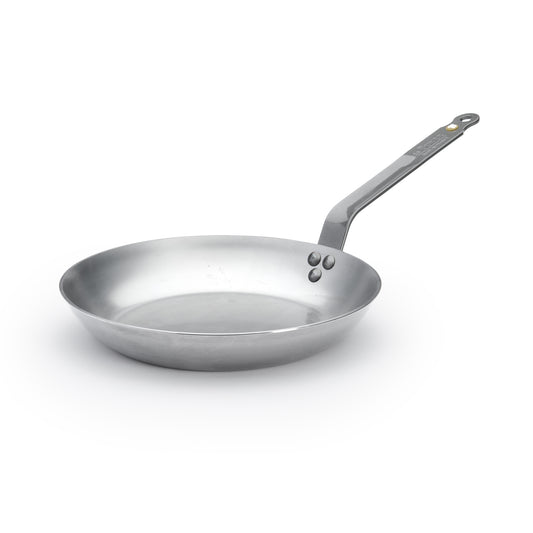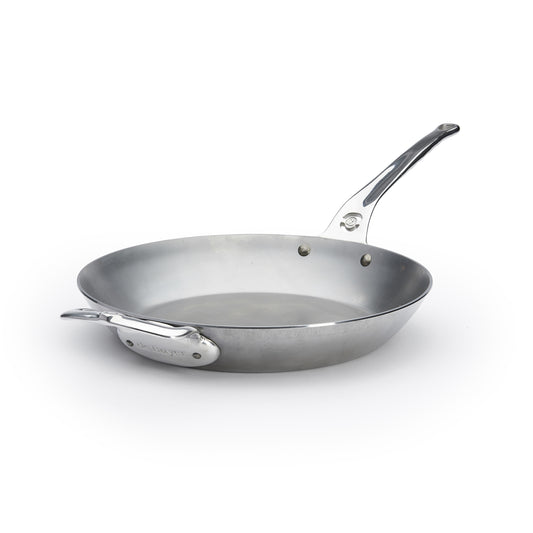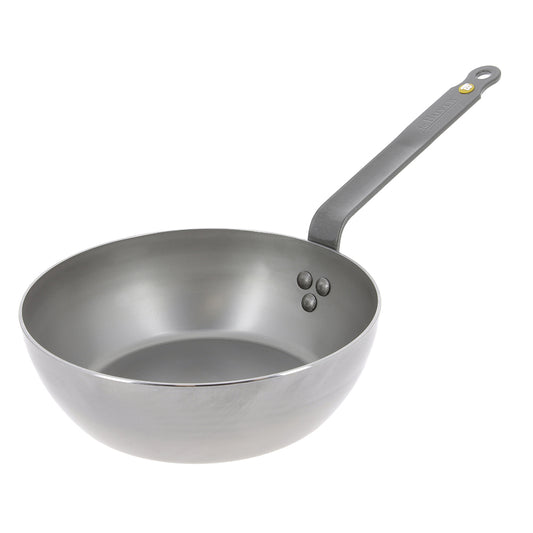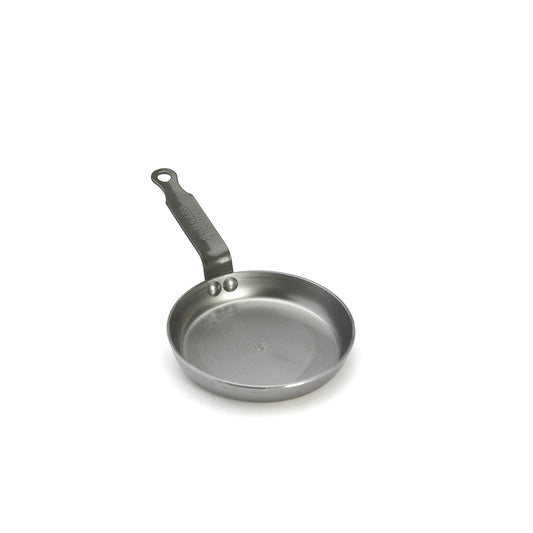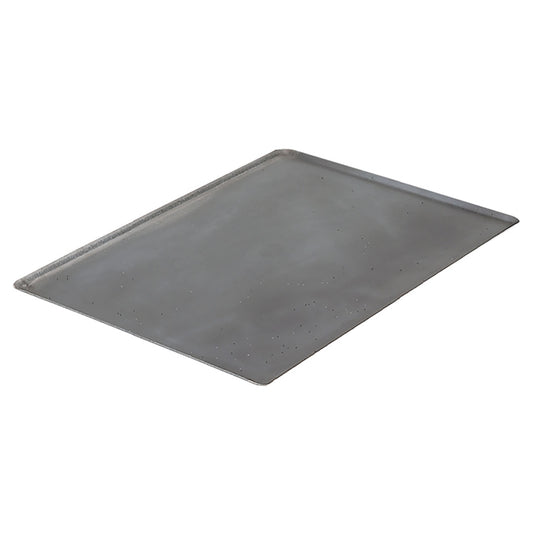What Is Carbon Steel Cookware? A Guide for Discerning Cooks
Wondering what is carbon steel cookware, exactly, and how can it benefit your kitchen? Learn the perks of working with carbon steel and unique chef hacks.
de Buyer

With origins tracing back to ancient China, carbon steel cookware has been refined and perfected over centuries, eventually gaining popularity in France and spreading to kitchens worldwide. While modern cookware is varied and impressive, a carbon steel cooking surface is still hallowed for achieving culinary excellence in the kitchen.
Carbon steel pans remain a favorite of professional chefs and home cooks alike due to their durability, unique properties, and incredible tolerance to high heat. This article will explore the benefits and versatility of these cookware sets, discuss best maintenance practices, and explain what you should know before purchasing carbon steel.
What Is Carbon Steel Cookware?
The specialized carbon steel items at de Buyer are made with 99% iron and 1% carbon, giving them the speed and responsiveness of stainless steel cookware with cast iron's heat retention and seasonality. Carbon pans have the additional benefit of being lighter than cast iron and comparable to stainless steel pans.
For professional chefs and passionate home cooks seeking superior performance in their culinary endeavors, the allure of carbon steel cookware is near irresistible. These usable pans fulfill a unique and powerful role in the kitchen.
They can be a workhorse item for a busy test kitchen, a lighter-weight brunch crafter, and a diverse sauce simmerer. Welcome to the carbon steel world, where you get exceptional heat conductivity, durability, and versatility.
The Many Faces of Carbon Steel Cookware
Versatility is the name of the carbon steel game. This type of cookware can adapt to a wide range of cooking techniques and recipes. First, carbon steel pans can seamlessly transition from stovetop to oven, making them ideal for dishes that require both searing and finishing.
Their diverse properties make carbon excellent for various cuisines, from searing meats to sautéing vegetables and even cooking delicate dishes like fried eggs, omelets, and crepes.
The Advantages of Carbon Steel Cookware
Carbon steel cookware offers a host of advantages that explain its constant spot in a chef’s must-have arsenal. Below are some of the most compelling reasons to shop for carbon steel:
- Rapid Heat Response: Carbon steel responds exceptionally well to the fast heat response of induction cooktops and gas power. They will heat very quickly without taking on any damage. They can also cool more rapidly than other metals without breakage.
- Even Heat Distribution: These carbon pans heat evenly and maintain that heat throughout the pan. This makes it much easier to sear across the entire pan surface.
- Excellent Maillard Reaction: Carbon steel pans are ideal conductors of the Maillard reaction, in which natural food sugars caramelize, sealing in flavor and moisture. This process produces a delicious, complex taste vital in most cooking forms.
- Perfect Nonstick Cookware: According to the experts, perfect nonstick properties come from pans that don't use chemicals. Carbon steel has the unique benefit of creating a naturally nonstick surface without using chemicals.
- Durable: These pots and pans can take a beating. These cookware items are incredibly durable and offer high tensile strength.
- Sloped Sides: Unlike cast iron, carbon steel pots usually have a sloped side, which makes it easier to scrape foods from the pan and simmer evenly.
The best carbon steel pans significantly benefit your professional space or home kitchen. Over time, these cookware items will develop a lovely patina (seasoned surface of the cookware) that enhances their performance and creates a tough cooking surface.
Considerations When Choosing Carbon Steel Cookware
Carbon steel is a fantastic cookware material, but there are some things you should know before purchasing. Unlike a cast iron skillet, which is 100% made of cast iron, most carbon steel pans have a stainless steel handle attached to the pan with rivets. This attachment means that the handle and pot heat responsiveness may differ. We recommend using a protective sleeve handle to avoid undue burns.
Unlike most modern cast iron pans, most carbon steel pans do not come as an already seasoned pan. These types of pans will need to be seasoned before use. Contrary to popular myth, the seasoning process is not intended to build a flavor profile. It aims to protect a pan from rust and give your carbon steel or cast iron pans a natural, non-stick coating.
Unlike artificial nonstick pans (think Teflon), a natural nonstick surface is non-toxic and easy to maintain throughout the pan's life. However, with carbon steel, you will need to take additional maintenance steps to keep the pan seasoned.
Avoid simmering acidic foods like tomatoes or vinegar-based dishes in your carbon steel skillet, as this will strip the seasoning off.
Caring for Your Carbon Steel Companion
Maintained and seasoned carbon steel is a must-have in every chef's tool kit. Properly seasoning, cleaning, and maintaining carbon steel cookware will ensure its longevity and optimal performance.
There are two ways to perform the seasoning process on your carbon steel pan: in the oven and on the stovetop. Both methods achieve the same result, but oven seasoning should only be done with our Mineral B PRO and Blue Carbon Steel collections. Mineral B should be seasoned on your stovetop.
Since our cooking utensils don’t come pre-seasoned, follow this seasoning process immediately after purchase:
Hand Wash
Use hot water and a gentle bristle brush to remove the beeswax coating, a protective layer applied at the factory to prevent rust before seasoning. Completely dry the pan and repeat if you notice a lingering waxy finish.
Oven Seasoning (Oven-Safe Mineral B PRO and Blue Carbon Steel Collections Only)
- Oil Your Pan and Heat Oven: Use a neutral oil like grapeseed or canola. Preheat your oven to the smoke point of your chosen oil, typically around 450°F.
- Heat in the Oven: Place your pan in the oven for an hour. Allow it to cool, and now your high-quality carbon steel pan is ready for use.
Stovetop Seasoning (All Carbon Steel Collections)
- Remove Beeswax: Hand wash as described above.
- Oil Your Pan: Use a dry dishcloth or paper towel to rub an extremely thin layer of oil over the pan. Use only 3-4 drops; too much oil will affect the seasoning process and be difficult to reverse.
- Heat on Stovetop: Heat the carbon steel frying pan over a burner on medium-high. The oil will start to smoke, and the pan will begin turning a dark brown color. This is the seasoning!
- Wipe Off Excess Oil: Wipe off any remaining oil after the pan cools. You can repeat the process 1-2 more times, but your pan will continue to season naturally the more you cook with it.
You don’t need to constantly re-season. It becomes necessary only when your pan is rusted, extremely dirty, or acidic food has stripped the original season.
Properly cleaning your pans will preserve the natural patina and prevent corrosion. Use mild soap, warm water, and a gentle brush to clean your carbon steel pan. Avoid soaking the pan for longer than a few minutes.
Embrace the Timeless Magic of Carbon Steel with de Buyer
Carbon steel utensils have fantastic heat distribution and responsiveness, are durable, and are easy to handle. These unique qualities make carbon steel cookware an excellent choice for a fast-paced professional kitchen or the discerning home cook.
This versatile and enduring kitchen essential will elevate your cooking experience and expand your recipe repertoire. The high-quality carbon steel cookware found in de Buyer's renowned French collection unlocks a world of culinary possibilities. Discover the best cookware, from a powerful carbon steel wok to a frying pan perfect for stir-frying.
Explore de Buyer's exquisite selection of carbon steel cookware and discover the perfect companion for your culinary journey.
Learn More
Recommended for You
-
MINERAL B PRO Carbon Steel Fry Pan
Regular price $90.00Regular priceUnit price / per$0.00Sale price $90.00 -
MINERAL B Classic Carbon Steel Fry Pan
Regular price $60.00Regular priceUnit price / per -
MINERAL B Carbon Steel Omelette Pan
Regular price $65.00Regular priceUnit price / per -
MINERAL B PRO Carbon Steel Omelette Pan
Regular price $105.00Regular priceUnit price / per -
MINERAL B Carbon Steel Crepe & Tortilla Pan
Regular price $70.00Regular priceUnit price / per -
Protective Sleeve for Pan Handle
Regular price $9.95Regular priceUnit price / per -
MINERAL B PRO Carbon Steel Fry Pan with Helper Handle
Regular price $145.00Regular priceUnit price / per -
Blue Carbon Steel Fry Pan
Regular price $45.00Regular priceUnit price / per -
Blue Carbon Steel Crepe & Tortilla Pan
Regular price $25.00Regular priceUnit price / per -
MINERAL B Carbon Steel Country Fry Pan
Regular price $100.00Regular priceUnit price / per -
MINERAL B Carbon Steel Egg & Pancake Pan
Regular price $35.00Regular priceUnit price / per -
Blue Carbon Steel Rectangular Baking Sheet
Regular price $35.00Regular priceUnit price / per













